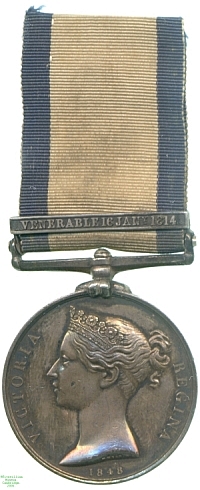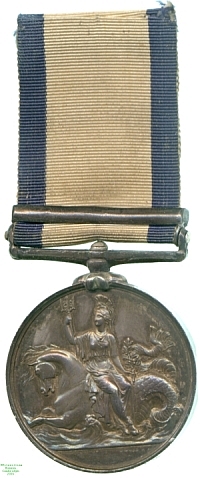
Obverse, a bust of Queen Victoria

Reverse, Britannia with a trident seated sideways on a seahorse

Obverse, a bust of Queen Victoria |

Reverse, Britannia with a trident seated sideways on a seahorse |
Just as in 1848 the extensive land campaigns of the Napoleonic Wars and the other conflicts of the pre-Victorian era were recognised by the issue of the Military General Service Medal, those serving in the Navy at the time were recognised with the Naval General Service Medal. As with the Army equivalent and the East India Company's related award, many of the battles for which the medal was awarded had been fought so long ago that few if any claimants survived.
In addition, bars were awarded for many actions whose significance and size were, despite the heroism displayed by those involved, relatively minor. The result was that many of the bars were issued in tiny numbers, with some combinations all but unique, and the medals command a very high price among collectors because of this rarity and individuality. This in turn, along with the manufacture in most cases of more bars than were eventually issued, has led to the `improvement' of many common awards where recipients' names are shared with those present at `rarer' battles. The medal also shares with the Military General Service and Army of India Medals the oddity that Queen Victoria, whose portrait they bear, was not the ruler under whom the battles for which it was awarded were fought.
Among the closing encounters of the Napoleonic Wars at sea was the one for which the bar to this medal was awarded, in which the British frigates HMS Venerable and HMS Cyane, and the prize brig HMS Jason which despite having only two guns maintained the battle by herself at several points, captured two French frigates, Alcmène and Iphigénie, off the Canary Islands.
This example of the medal was awarded to Boy William Fowler, whose service on the Venerable has been verified. The Medals Roll also confirms the award of the piece to him, although men of the same name were also awarded the rather more common awards for Algiers and Syria. Lester Watson bought this medal from the dealer Gifford at some point before 1928; it may have previously formed part of the Gray Collection.